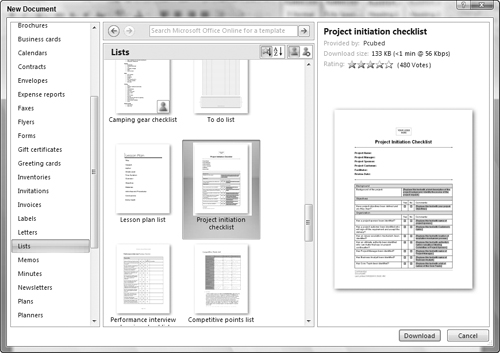Creating a File from a Template
You need not start every document that you create from scratch. You can instead select a template that supplies design settings and in many cases starter text on which you can base your own document content. The Office applications offer many templates, both installed on your system and available online. In Word, you can choose from a variety of different templates to get your document started.
Understanding templates
Every new document you create in Word—even a blank document—is based on a template that specifies basic formatting for the document such as margin settings and default text styles. When you create a blank document, Word automatically applies the default global template, Normal.dotm.
In other instances, you can select a specific template to use as the basis for a new document. A template can include not only design elements, but also labels and starter text and placeholders for your information. For example, you can select a fax template that holds predefined labels and positions for recipient name, fax number, and more. Or, you can choose resume template that defines a nice layout has placeholders that you select and replace to add your own resume information.
Installing Word 2007 installs a variety of letter, resume, fax, and report templates on your system. Word also enables you to download templates from dozens of different categories from Office Online. There are downloadable templates for brochures, business cards, memos, purchase orders, and more.
Creating the file from the template
Using a template for a new file starts out just like creating a blank file. The New Document dialog box enables you to browse for an select a template and in most cases to see a preview before you select the template to use. Follow these steps to create a new document based on a template:
1. | Select Office Button |
2. | Click either Installed Templates in the Templates section in the left-hand list, or click a template category under Microsoft Office Online. Thumbnails and names for the available templates in the selected category appear in the middle section of the dialog box. |
3. | Click the thumbnail for the desired template. A preview for the template appears at the right, as shown in Figure 4-4. |
4. | Click the Create button to create the new file from an installed template, or click Download to create the new document from a selected online template. If you’re downloading a template, the Microsoft Office Genuine Advantage dialog box appears. |
5. | Click Continue to validate your software installation and download the template. |
The new document appears onscreen.
Note
Some of the templates available via Office Online were created in earlier Word versions. Those documents will open in compatibility mode, which is described later in this chapter.
Working with template content
As shown in Figure 4-5, a template might hold a variety of different sample content and placeholders.
You can work with these placeholders and other contents as follows to finish your document:
Graphics placeholders. The box at the top of Figure 4-5 that says Your Logo Here is a placeholder for a graphic. Click the placeholder to select it, click the Insert tab on the Ribbon, and then click the Picture or Clip Art choice in the Illustrations group to select a replacement item. Chapter 9, “Tables and Graphics,” provides more information about working with artwork in your Word documents.
Labels for text. If you were to click to the right of the colon for any of the label items listed immediately below Project Initiation Checklist in Figure 4-5, the insertion point would appear at a precise position, ready for you to enter the text to go with the label.
Gray field placeholders. Template text that appears with square brackets and gray shading are text form fields. Clicking one of these placeholders selects the entire placeholder, and then any text you type replaces the placeholder contents.
Other text. You can supplement the template’s contents by adding your own text anywhere in the document.
Styles. Templates also include predefined styles (formatting) that you can apply to text that you add. See Chapter 7 to learn more about applying styles to text.


